Botanical Marvels at Dartford Heath 2nd May 2015
To most people Dartford Heath is somewhere to walk the dog and many let their dogs mess everywhere which is a shame. The obvious flower most of the time is Gorse, the rest looking like parkland grass.
What you don't obviously see if there are hundreds of thousands of flowering plants in the grasses, most very small and easily missed. Some are rare in Kent and nationally.
However, I'll start off with the commoner plants. After all, if you see the rarities now you might not read the rest!
Common Storksbill were flowering in large numbers, their tiny pink flowers glistening in the sunlight of this pleasant Spring day.
Erodium cicutarium
This is Common Mouse-ear, another common plant. Also present were numerous sticky Mouse-ears with glandular hairs and tightly bunched tiny flowerheads.
Cerastium fontanum
There were hundreds of tiny Dovesfoot and Round-leaved Cranesbills (pictured) dotting the grasses with pink flowers.
This one is a variant white form, there was a patch of about 20 or so, all white with pink veins, beautiful!
Geranium rotundifolium var alba
Where there's wildflowers there's butterflies like this lovely Brimstone.
I also saw Red Admiral and Small Tortoiseshells but failed to get photos of those.
In amongst the Gorse I noticed a very unusual Broom with red and yellow flowers. Native Broom has all yellow flowers. The RHS describe it as Scotch Broom.
This is an ornamental escape but well away from houses. I always wonder how these escapes get to where they grow.
Cytisus scoparius f. andreanus
I stopped to tie up a shoelace and noticed something tiny but colourful in the grass.
I was very pleased to find Birdsfoot, only a few millimetres big but having the most wonderful flowers.
These aren't yet rare, but they are the first I've seen in 3 years of botany in Kent.
Once I knew what to look for, I found several colonies dotted around the heath. They really are hard to see!
Ornithopus perpusillus
Now I was looking at the grass for millimetre high flowers I stumbled across these beautiful Upright Chickweed in flower. They look like miniature crocuses and again are no more than about 1cm tall!
They never fully open and the photo here shows one about as open as they go, but the white edged sepals and white petals look a treat.
They are listed on the Kent Rare Plant Register (RPR) and have been known on the Heath for some years, but again was an exciting first for me.
Moenchia erecta
In this photo are thousands of Upright Chickweed flowers, right in the foreground and stretching back towards the tree. People walk by oblivious to their presence.
Here's a final photograph to show you the scale!
Oddly enough, once I knew what to look for I found thousands in flower in several locations, all so easily missed.
Another butterfly came along, this time a Peacock feeding on a Dandelion, an important nectar source to many insects. If you have a lawn, leave mowing it for as long as you can or maybe make a mini meadow of your own?
Peacock Butterfly
I then found a few Heath Dog Violets. These are the only violet in the UK with bright blue flowers. A pale thin cream yellow spur also helps to identify them. These are now threatened in Kent and are also on the RPR.
Viola canina
This is the type of area where I found Birdsfoot and the Heath Dog Violets, along with growing Heather and Bell Heather
As I walked on, an area was turning rust red in colour with hundreds of Sheeps' Sorrel coming into flower.
These are a member of the Dock family, but their red coloured flowerheads (but no petals) can dominate large swathes of heathland in Spring.
Rumex acetosella
In shadier areas grew stands of Garlic Mustard, common along roadsides, paths and hedgerows in Spring. They are an important food source for the Orange Tip butterfly which also lays its eggs on them.
So every time they are ripped up and "weeded" another butterfly habitat disappears, leave them, they are an attractive flower and die off by Summer.
Alliaria petiolata
A noticable character of the heath is that like Dungeness on the coast, there are several garden escapes doing well there.
This one is Honesty, better known for its disc like seeds that go transparent in florist displays
This is another plant favoured by Orange White and other white butterflies.
Lunaria annua
Here is another tiny plant of the turf, a Wall Speedwell. Contrary to their name I have found them all on very short turf on thin soils. This Speedwells' flowers have no visible flower stalk making it easy to identify. The flowers do open fully, but not for me this day.
This whole plant was only about an inch tall, though I have seen some giant plants of around 6" at Cliffe!
Veronica arvensis
Another Cabbage Family member is now flowering, this is Hoary Cress, often seen on waste ground and road verges in huge numbers.
Many small flies, hoverflies and insects feed on their nectar.
Lepidium draba
Some Bluebells flowering with the Gorse, an odd mixture as they are usually found under trees in woodlands.
Hyacinthoides non scripta
I was then absolutely delighted to see a Small Copper Butterfly, pointed out by my partner.
Their population has crashed in recent years and it would be a great shame if these die out in Kent.
The final small plant in the turf was quite common but usually missed being small. It's a Lesser Trefoil with only a few flowers (5-10) in the cluster. Hop Trefoil looks similar but there will be 20+ flowers (looking like a mini hop flower)
Trifolium dubium
We followed a main road for a while back to the car park and the better soils favoured flowers like these Common Vetch. Their flowers are about 1-2cm long sometimes bigger and are always in singles or pairs.
The pairs of leaves are pointed with branched tendrils wrapping around anything they can to support the plant.
Vicia sativa
A few Ox-Eye Daisies were beginning to show by the road.
Leucanthemum vulgare
The final plant on the heath was Green Alkanet (with its blue flowers). A stunning Green-Veined White butterfly landed to feed while I was there, fantastic!
We then drove off from a wonderful morning on the heath but stopped at a few places on the way home.
This is Crosswort, another RPR species on the Butterfly Conservation reserve at White Hill near Shoreham, Kent. Its ring of tiny bright yellow flowers in the leaf axils and hairy look are distinctive.
Cruciata laevipes
While there I saw many Grizzled Skipper butterflies which are the size of a medium moth. The brown and white patterns though are very distinctive.
It was feeding on the tiny flowers of Common Milkwort (Polygala vulgaris)
I managed a double by photographing this Dingy Skipper which is, well, dingy!
Both of these Skippers are not common in North Kent and were a delight to see. While there were numerous Grizzlies about there was but one Dingy Skipper.
This is probably a Common Cornsalad, however, they can't easily be identified unless fruits are present and there aren't!
Valerianella sp.
Right by the main A225 near Eynsford is a colony of Man Orchids, with some now in bud. In just a couple of weeks the first flowers will be out shaped like little men dangling from the stem
Orchis anthropophora
Finally, on an old railway bridge parapet was the delightful tiny Rue-Leaved Saxifrage, very common on thin soils of brownfield sites, old walls and castles (of which there are many in Kent)
Saxifraga tridactylites
There's more and more to see now Spring has finally arrived. Many orchids are about to flower along with the Summer favourites like Poppies. Get out there and immerse yourself in nature, sit in the shade under a tree, walk by a babbling brook, breathe it all in and enjoy.
Dave
@Barbus59
What you don't obviously see if there are hundreds of thousands of flowering plants in the grasses, most very small and easily missed. Some are rare in Kent and nationally.
However, I'll start off with the commoner plants. After all, if you see the rarities now you might not read the rest!
Common Storksbill were flowering in large numbers, their tiny pink flowers glistening in the sunlight of this pleasant Spring day.
Erodium cicutarium
This is Common Mouse-ear, another common plant. Also present were numerous sticky Mouse-ears with glandular hairs and tightly bunched tiny flowerheads.
Cerastium fontanum
There were hundreds of tiny Dovesfoot and Round-leaved Cranesbills (pictured) dotting the grasses with pink flowers.
This one is a variant white form, there was a patch of about 20 or so, all white with pink veins, beautiful!
Geranium rotundifolium var alba
Where there's wildflowers there's butterflies like this lovely Brimstone.
I also saw Red Admiral and Small Tortoiseshells but failed to get photos of those.
In amongst the Gorse I noticed a very unusual Broom with red and yellow flowers. Native Broom has all yellow flowers. The RHS describe it as Scotch Broom.
This is an ornamental escape but well away from houses. I always wonder how these escapes get to where they grow.
Cytisus scoparius f. andreanus
I stopped to tie up a shoelace and noticed something tiny but colourful in the grass.
I was very pleased to find Birdsfoot, only a few millimetres big but having the most wonderful flowers.
These aren't yet rare, but they are the first I've seen in 3 years of botany in Kent.
Once I knew what to look for, I found several colonies dotted around the heath. They really are hard to see!
Ornithopus perpusillus
Now I was looking at the grass for millimetre high flowers I stumbled across these beautiful Upright Chickweed in flower. They look like miniature crocuses and again are no more than about 1cm tall!
They never fully open and the photo here shows one about as open as they go, but the white edged sepals and white petals look a treat.
They are listed on the Kent Rare Plant Register (RPR) and have been known on the Heath for some years, but again was an exciting first for me.
Moenchia erecta
In this photo are thousands of Upright Chickweed flowers, right in the foreground and stretching back towards the tree. People walk by oblivious to their presence.
Here's a final photograph to show you the scale!
Oddly enough, once I knew what to look for I found thousands in flower in several locations, all so easily missed.
Another butterfly came along, this time a Peacock feeding on a Dandelion, an important nectar source to many insects. If you have a lawn, leave mowing it for as long as you can or maybe make a mini meadow of your own?
Peacock Butterfly
I then found a few Heath Dog Violets. These are the only violet in the UK with bright blue flowers. A pale thin cream yellow spur also helps to identify them. These are now threatened in Kent and are also on the RPR.
Viola canina
This is the type of area where I found Birdsfoot and the Heath Dog Violets, along with growing Heather and Bell Heather
As I walked on, an area was turning rust red in colour with hundreds of Sheeps' Sorrel coming into flower.
These are a member of the Dock family, but their red coloured flowerheads (but no petals) can dominate large swathes of heathland in Spring.
Rumex acetosella
In shadier areas grew stands of Garlic Mustard, common along roadsides, paths and hedgerows in Spring. They are an important food source for the Orange Tip butterfly which also lays its eggs on them.
So every time they are ripped up and "weeded" another butterfly habitat disappears, leave them, they are an attractive flower and die off by Summer.
Alliaria petiolata
A noticable character of the heath is that like Dungeness on the coast, there are several garden escapes doing well there.
This one is Honesty, better known for its disc like seeds that go transparent in florist displays
This is another plant favoured by Orange White and other white butterflies.
Lunaria annua
Here is another tiny plant of the turf, a Wall Speedwell. Contrary to their name I have found them all on very short turf on thin soils. This Speedwells' flowers have no visible flower stalk making it easy to identify. The flowers do open fully, but not for me this day.
This whole plant was only about an inch tall, though I have seen some giant plants of around 6" at Cliffe!
Veronica arvensis
Another Cabbage Family member is now flowering, this is Hoary Cress, often seen on waste ground and road verges in huge numbers.
Many small flies, hoverflies and insects feed on their nectar.
Lepidium draba
Some Bluebells flowering with the Gorse, an odd mixture as they are usually found under trees in woodlands.
Hyacinthoides non scripta
I was then absolutely delighted to see a Small Copper Butterfly, pointed out by my partner.
Their population has crashed in recent years and it would be a great shame if these die out in Kent.
The final small plant in the turf was quite common but usually missed being small. It's a Lesser Trefoil with only a few flowers (5-10) in the cluster. Hop Trefoil looks similar but there will be 20+ flowers (looking like a mini hop flower)
Trifolium dubium
We followed a main road for a while back to the car park and the better soils favoured flowers like these Common Vetch. Their flowers are about 1-2cm long sometimes bigger and are always in singles or pairs.
The pairs of leaves are pointed with branched tendrils wrapping around anything they can to support the plant.
Vicia sativa
A few Ox-Eye Daisies were beginning to show by the road.
Leucanthemum vulgare
The final plant on the heath was Green Alkanet (with its blue flowers). A stunning Green-Veined White butterfly landed to feed while I was there, fantastic!
We then drove off from a wonderful morning on the heath but stopped at a few places on the way home.
This is Crosswort, another RPR species on the Butterfly Conservation reserve at White Hill near Shoreham, Kent. Its ring of tiny bright yellow flowers in the leaf axils and hairy look are distinctive.
Cruciata laevipes
While there I saw many Grizzled Skipper butterflies which are the size of a medium moth. The brown and white patterns though are very distinctive.
It was feeding on the tiny flowers of Common Milkwort (Polygala vulgaris)
I managed a double by photographing this Dingy Skipper which is, well, dingy!
Both of these Skippers are not common in North Kent and were a delight to see. While there were numerous Grizzlies about there was but one Dingy Skipper.
This is probably a Common Cornsalad, however, they can't easily be identified unless fruits are present and there aren't!
Valerianella sp.
Right by the main A225 near Eynsford is a colony of Man Orchids, with some now in bud. In just a couple of weeks the first flowers will be out shaped like little men dangling from the stem
Orchis anthropophora
Finally, on an old railway bridge parapet was the delightful tiny Rue-Leaved Saxifrage, very common on thin soils of brownfield sites, old walls and castles (of which there are many in Kent)
Saxifraga tridactylites
There's more and more to see now Spring has finally arrived. Many orchids are about to flower along with the Summer favourites like Poppies. Get out there and immerse yourself in nature, sit in the shade under a tree, walk by a babbling brook, breathe it all in and enjoy.
Dave
@Barbus59
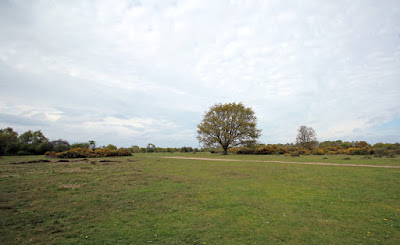













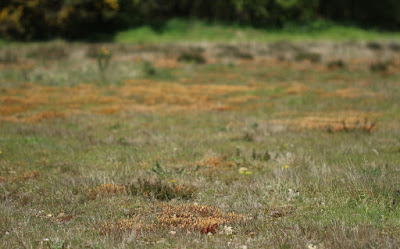











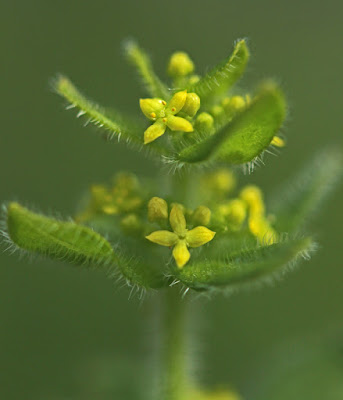






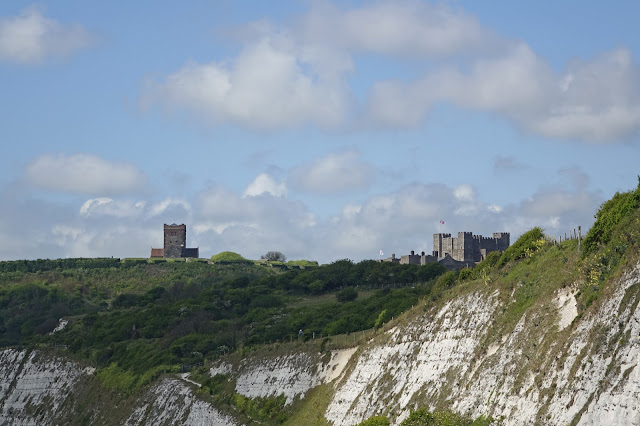
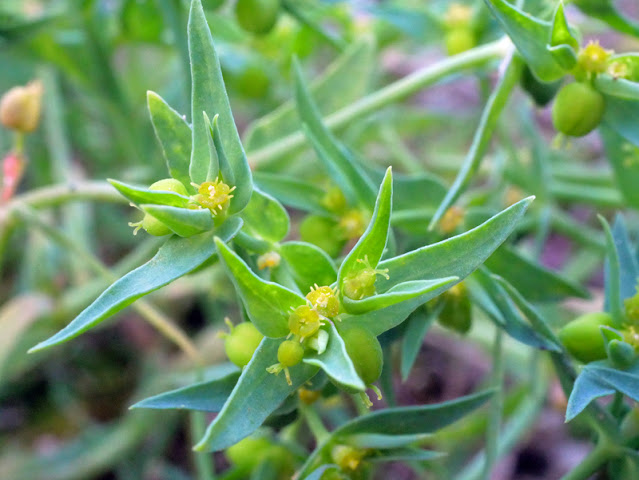
I am astonished to see such a variety of flora in your area of the country! Very interesting post and always educational!
ReplyDelete